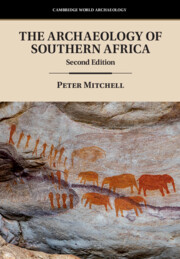Book contents
- Frontmatter
- Contents
- List of Figures
- List of Tables
- Acknowledgments
- 1 Introduction
- 2 Frameworks
- 3 Contexts
- 4 Origins
- 5 A Cognitive Revolution
- 6 Hunter-Gatherers of the Late Pleistocene
- 7 Archaeologies of the Pleistocene/Holocene Transition
- 8 Hunting, Gathering, Intensifying: Forager Histories in the Holocene before 2000bp
- 9 Taking Stock: Herders and Hunter-Gatherers
- 10 Farmers and Foragers: the First Millennium
- 11 Forming States: the Zimbabwe Culture and its Neighbours
- 12 Recent Farmers and Hunter-Gatherers in Southernmost Africa
- 13 Colonisation, Conquest, Resistance
- 14 Perspectives and Prospects
- Glossary
- References
- Index
11 - Forming States: the Zimbabwe Culture and its Neighbours
Published online by Cambridge University Press: 15 May 2024
- Frontmatter
- Contents
- List of Figures
- List of Tables
- Acknowledgments
- 1 Introduction
- 2 Frameworks
- 3 Contexts
- 4 Origins
- 5 A Cognitive Revolution
- 6 Hunter-Gatherers of the Late Pleistocene
- 7 Archaeologies of the Pleistocene/Holocene Transition
- 8 Hunting, Gathering, Intensifying: Forager Histories in the Holocene before 2000bp
- 9 Taking Stock: Herders and Hunter-Gatherers
- 10 Farmers and Foragers: the First Millennium
- 11 Forming States: the Zimbabwe Culture and its Neighbours
- 12 Recent Farmers and Hunter-Gatherers in Southernmost Africa
- 13 Colonisation, Conquest, Resistance
- 14 Perspectives and Prospects
- Glossary
- References
- Index
Summary
From the early second millennium AD more hierarchically organised societies marked by the rise of southern Africa’s first states developed in the north of southern Africa, culminating in Great Zimbabwe and its successors. This chapter outlines the processes involved, including the roles played by hunter-gatherer communities (for example at K2 and Mapungubwe) and the histories of farming societies on their periphery (notably those of Zimbabwe’s Nyanga Highlands). Much of this research is new and the past two decades have also seen challenges emerge to the importance previously accorded Indian Ocean trade in accounting for the emergence of social complexity, to the historical relationships between major centres (K2, Mapungubwe, Great Zimbabwe, Khami), and to understandings of the internal organisation, chronology, size, and functioning of those sites. Discussing these debates – particularly those relating to the settlement organisation of Great Zimbabwe and other stone-walled sites and the social implications of this – involves considering how far political action should be understood in terms of Indigenous, rather than Western, concepts.
Keywords
- Type
- Chapter
- Information
- The Archaeology of Southern Africa , pp. 314 - 358Publisher: Cambridge University PressPrint publication year: 2024



